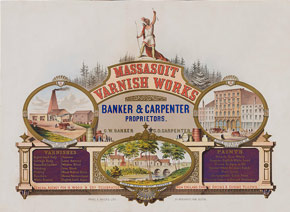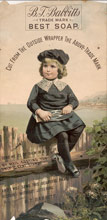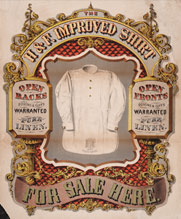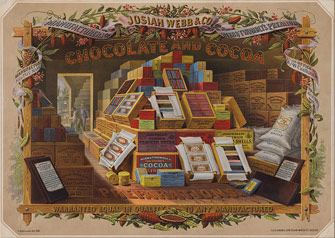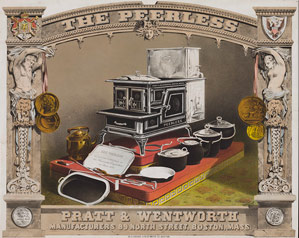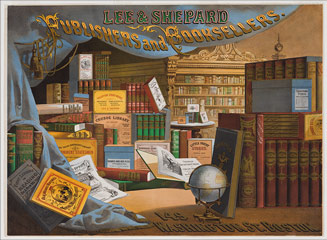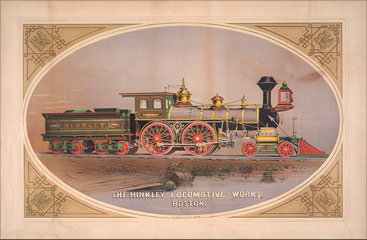The Art of American Advertising:
The Art of “Posting”
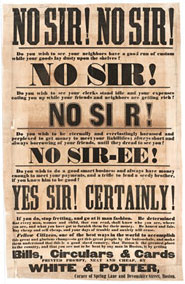
“[Posting] is so big, so forceful, so always-before-you-and-never-to-be-thrown-away that it is bound to command unusual attention in the small town or city.”G. H. E. Hawkins, Poster Advertising, 191032
Unlike more intimate advertising media such as trade cards or souvenir publications, broadsides and posters occupied the domain of large public spaces—their size being a significant advertising asset. In his 1910 guidebook on poster advertising, G. H. E. Hawkins explained, “The possibility of reproducing a trade-mark, figure, or the article itself, in mammoth size tends to impress it upon the mind in an uncommon way and with great force.”33
Broadsides, single-sided sheets with black-and-white typeface, commonly announced formal proclamations and public events. They served as commercial advertisements as well and were familiar sights on public walls and fences. While advertisers faced little regulation about the placement of broadsides, they needed to be wary of competitors who might tear down their postings or cover them up with their own advertisements. Advances in chromolithography in the late nineteenth-century elevated the advertising poster to an art form that caught the attention of consumers through its dynamic compositions and striking colors. Posters were pasted on buildings, streetcars, railroad routes, and barns, and salesmen also encouraged the display of miniature versions of posters in the windows of stores where products were sold.
“There are several general billposters of large capital in the United States who employ an army of men and own space and have facilities for covering any state or number of states. They have brought billposting to a science,” Sidney Sherman noted in his 1900 study of advertising in the United States.34 The Associated Billposters of the United States and Canada began to regulate the industry, including setting prices and length of time a poster would be displayed. Advertisers sent out local representatives, traveling salesmen, or telegraph messengers with checklists to inspect the distribution, placement, and condition of posters. At times the public landscape became so saturated with marketing images that some state legislations called for a limitation on their use.
While posters provided a large space to work within, advertisers generally kept to a single slogan or line of argument. As Fowlers Publicity Encyclopedia reasoned, “It is more profitable to have twenty-five readable words on the poster than to let it contain one hundred words that people cannot see without an opera glass.”35 Hawkins offered advice on style, layout, and the use of good paper and non-fading inks. “Shun the cheap poster and buy the best the lithographer can turn out,” he argued. “The posting costs nearly ten times the cost of the poster—and the expense of posting is just the same for a bad poster as a good one.”36
Many well-known lithographers of the day made their living from both artistic and commercial commissions. They included Currier and Ives in New York and Louis Prang and Charles H. Crosby in Boston. Print curators Sally Pierce and Catharina Slautterback note that chromolithographs printed by Crosby were “among the most spectacular and beautifully colored examples of the genre printed in Boston.”37 To keep up with the market demand, Crosby reportedly ran as many as fifty presses in four locations.38 His prints promoted books, chocolates, elixirs, ovens, and locomotive trains, a particularly popular subject that crossed the line between art and advertising. As the Railroad Advocate observed in 1856, “The various locomotive builders are getting up very handsome colored lithographs of their machines. . . . They are the appropriate adornments for the offices of every variety of business connected with railroads.”39
Fine art and advertising went hand in hand. As one lithographer explained, “True, our pictures are many of them for the soap manufacturer, the insurance companies, and the patent-medicine man; but we try in our way to be educators of the people, and to give them good drawing and harmonious coloring. These business patrons of ours who use pictures for advertising purposes know that the public have become fastidious; hence they will only accept good designs.”40 The name of a prominent artist attached to an advertisement lent a certain prestige to a product. Lithographers might initially create prints as works of art, which were later appropriated for advertisements, and conversely advertising prints came to be regarded as works of art. It all worked to the advantage of businesses seeking to hold the gaze of the consumer.
32 G. H. E. Hawkins, Poster Advertising. Chicago: G.H.E. Hawkins, 1910, p. 22.
33 Hawkins, p. 1.
34 Sherman, p. 126.
35 Fowlers Publicity Encyclopedia. Volume III, Posters, Chapter XXXIII.
36 Hawkins, p. 12.
37 Pierce and Slautterback, p. 135.
38 See Pierce and Slautterback, p. 13.
39 Railroad Advocate, November 8, 1856 in Peter C. Marzio, p. 193.
40 Art Amatuer, December 1894, p. 15, in Marzio, p. 195.
